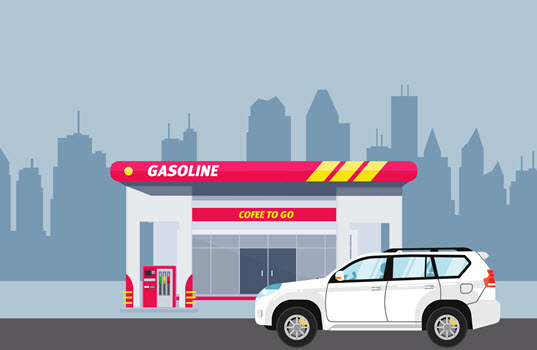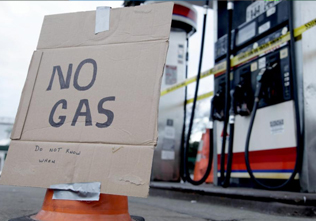For decades, fuel and C-stores have enjoyed a symbiotic relationship. Fuel purchases drive sales inside the c-store; c-store sales drive profits. But much is changing – and quickly—within the fuel and c-store industry. Consumer habits are shifting. Emerging technologies are transforming both the fundamentals of transportation and the shopping experience. With all this change in the air, will purchases at the pump continue to fuel a c-store’s bottom line?
Currently, an estimated 150,000 c-stores sell approximately 80 percent of the fuel purchased in the United States. The volume of fuel sales has trended upward the past three years, primarily due to the low cost and high supply of traditional fuels. That notwithstanding, there are many plausible reasons for fuel sales to begin shrinking in the long term—improved fuel economy, on-demand fueling services and autonomous driving, just to name a few. How will the future c-store not only survive but thrive under these circumstances? A look at demographics, urban planning, population density, consumer preferences and recent successful c-store strategies provides some insights.
Future Drivers
Data presented in the Fuels Institute’s report, “Driver Demographics,” shows the number of drivers in the U.S. steadily increased alongside U.S. population numbers from 1963 to 2010. The Fuels Institute estimates that the U.S. population will grow by almost 100 million people by 2060. Putting aside the possibility that transportation might transform so dramatically that cars as we know them become obsolete, let’s ask ourselves: will the growing population even want to drive 40 years from now? Consider this:
- Vehicle Miles Traveled (VMT) rose steadily from 1970 until the mid-2000s, when it plateaued (and has remained relatively stable) despite the growing population.
- Millennials currently represent the United States’ largest living generation. Fewer Millennials are driving compared to 20-somethings of the previous generation.
- In contrast, the number of drivers ages 50 to 60 increased about 250% from 1963 to 2010. The Fuels Institute described this increase as “unprecedented.” In the short-term, it off-sets the decrease in younger drivers. What is unclear is whether future older drivers (current Millennials) will exhibit the same behaviors as the current group of older Americans.
Future C-Store Shoppers/Diners
With C-store profitability tied to in-store sales, knowing how likely future customers are to buy goods from a convenience store is another indicator of a C-store’s ability to succeed in a future without fuel. Food for thought:
- Fewer Millennials may be driving than members of other age groups, but research shows they love shopping at c-stores.
- Consumers across numerous demographics (Millennials, Gen-Xers and older Americans) are dining out more than they were 20 years ago.
- People are snacking more and are eating on-the-go.
- C-stores food service sales represented the largest increase in in-store sales the past two years.
Location, Location, Location
How essential fuel will be to the future c-store product mix will also largely be determined by the c-store’s location and that location’s subsequent population density.
Data from the U.S. Census Bureau shows that more people are migrating to metro areas. In 1950, 56% of the U.S. population lived in metro areas; in 2010 84% of the population resided in metro areas. As for the Millennials, experts are divided about where this group wants to live. The conventional wisdom has been that Millennials prefer urban locations. But two recent reports (“The Zillow Group Report on Consumer Housing Trends” and “Improving America’s Housing 2017: Demographic Change and the Remodeling Outlook” by Harvard University) show otherwise. These reports suggest that many Millennials want an affordable home in the suburbs.
Cities and outlying areas also have inherently different transportation needs. Major metro areas offer residents the benefit of integrated public transit systems, which make having an automobile a matter of convenience/personal preference. In most suburbs, exurbs and all rural areas, public transportation often lacks accessibility and integration. Here an automobile is more of a necessity.
Major metro areas are already expanding ride-sharing opportunities, and urban planners are looking for creative ways to establish more transit efficiencies. Further, companies like Hyperloop One are testing high-speed transit systems that would redefine commuting (consider the possibility of commuting from Boston to New York City). These types of systems are largely unsustainable in low-population areas. For that reason, a dissimilarity between the transportation in big and small cities may grow.
Recipe for Success
C-stores already have a lot going for them, even without the fueling component. Unlike many larger brick-and-mortar retailers, convenience stores continue to flourish amid increasing challenges. Despite declining motor fuel revenue, higher operating expenses and increased competition from industry outsiders, convenience stores posted an in-store gain 50% higher than overall U.S. retail sales (excluding auto sales), according to a 2017 industry report. While favorable economic conditions have contributed to their success, the c-store’s ability to adapt has also been key.
Convenience stores continue to establish new ways to generate foot traffic. From on-site food preparation and “wellness” products, to gaming and beverage bars, the previously ordinary c-store is morphing into a place that will provide both your items of convenience and an experience that will encourage you to linger. This strategy has already positioned c-store operators to make up for diminishing returns on the forecourt.
For many consumers, time is as valuable an asset as money. To maintain the positive momentum that the convenience store industry is currently experiencing, C-store operators must keep pace with both product selection and customer-preferred sales channels. New c-store concepts like the cashier-less Amazon Go challenge traditional sales barriers. They cut a consumer’s time investment in the transaction process. Just as fuel is unlikely to disappear nationwide, the scale of these time-saving retail experiences is likely to vary by location. In booming urban areas sustaining efficient customer throughput could become a challenge. Grab-and-go stores pose a potential solution for maintaining positive customer experiences. In less populated areas, an app-assisted pick-up window may be enough to meet customers’ needs.
As the c-store industry evolves alongside transportation technologies, the role of fuel in some—but not all—c-store sales is likely to diminish. Addressing the needs of an individual market will become critical to maintaining strong margins. This will be especially true for independent marketers who lack support from a committed brand partner. In addition, multi-site operations that previously leveraged a singular brand experience, may find that one concept no longer fits all markets.
The convenience store industry will need to re-invent itself again to remain relevant. Thankfully, there’s plenty of evidence that shows the industry is up to the challenge.
SOURCE - “Fueled for Thought,” By Joe O’Brien, Source North America








